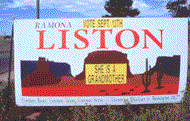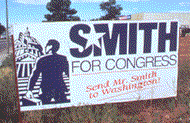
![]()
![]()
Introduction
----
How to Use
this Guide
----
Program
Descriptions
----
Previewing
Questions
----
Postviewing
Activities
----
Discussion
Questions
----
Enrichment
Activities
----
Student Page
----
Related
Resources
----
Credits
- Based on Vote for Me, Part I, have students generate an in-class definition of political culture. Ask students to use specific examples from the program to support their definition.

Photo: Andrew Kolker - As you watch Vote for Me, ask students to note all of the different methods candidates use to make themselves and their views known to voters. Some will probably mention speeches, television ads, billboards and political rallies. Ask them to select from their list those that merit their personal "superlative awards" (example: funniest logo, most attractive design, most memorable, most useful, etc.). Ask them to compare their choices with those of other students; compile a "hit parade" of items for the class to share.

New Mexico, 1994: Photo: Andrew Kolker - Designate one of the bulletin boards in the classroom as a campaign clearinghouse area. Each week for the four weeks prior to the election, display campaign literature for the candidates of a particular campaign. Update the bulletin board each week and note any changes in the tone of the campaign as election day draws near.
- In recent generations, partisan competition has transformed the once solidly Democratic South, into a Republican stronghold. How did that political change come about? Give specific examples from the series. What distinguishes the South of yesterday from the South of today?

Photo: Andrew Kolker - Brainstorm a list of techniques used by candidates to connect with the individual voter in California, in Chicago and in the suburbs. What are the differences among these three styles? Why are they different? Ask students to make a chart on the blackboard that shows which techniques work best in each area. Ask students which techniques would work best in their community and why?
- Learning basic political skills often makes the difference between winning and losing an election campaign. As you watch the program, make a list of the experiences and responsibilities a person should have to win an election or to obtain a nonelective job in politics. Develop a sample resume for such a person making sure you include the necessary elements for success.

aRusso for Mayor, Rhode Island, 1994; Photo: Paul Stekler - Divide the class into groups. Ask each group to create a list of courses which a fictitious college or university might offer potential politicians. Think about the skills a politician needs to be a success and create a curriculum to match. Give a name to each course and briefly describe it as it might appear in a college course selection guide.
- In Federalist 10 of the Federalist Papers, James Madison said that "a zeal for certain opinions concerning religion and government have divided mankind into parties, and inflamed them with mutual animosities." He said that "because of this, mankind would rather oppress each other than to cooperate for the common good."
Vote for Me provides many examples of fierce political rivalries. Ask students to read Federalist 10 and discover why Madison believed that this tension among diverse groups might actually benefit the people of an extended republic. Ask students to write a short reaction paper regarding their findings, including whether they agree with Madison's thinking. Encourage students to connect Madison's ideas as expressed in Federalist 10 to specific scenarios from the series.
- Ask students to imagine that they are a political candidate each writing potential constituents a letter outlining reasons they should elect you. Remind students to touch on the mega complaints about candidates mentioned often by voters in the series. The letters should address some of these complaints.

Make Way!, Laura Foster - Divide students into groups. Each group should select one of the areas discussed in the series, such as the Texas state legislature, the South Florida retirement community or Johnston, Rhode Island and list the distinctive cultural features of each. In a follow-up discussion, ask students to compare and contrast each groups findings noting any similarities and differences.
- After watching Kathleen Brown's 30-hour bus tour through California, in the first program of Vote for Me, students should divide into groups and come up with a list of campaign gimmicks that would attract free television coverage. Have each group present its campaign gimmicks in class and discuss which would be the most or least effective.
- Ask students to compare and contrast the workings of the Chicago political machine with the style of politics shown in western North Carolina. What does each system need in order to work? What cultural differences do they reflect?
- Have students divide into groups and discuss the positive and negative aspects of being a political figure. Ask students to make a chart on newsprint comparing and contrasting the series. What conclusions can each group draw about life as a political figure? Do the positives outweigh the negatives? Ask students to list three or four conclusions to share with the class.
- Watch Vote for Me and then write a review of the program for fellow students. Would you recommend that they watch the program if it is rebroadcast? Why? For its entertainment value? For information? Is there anything you would change about the program to improve it if you were in charge?